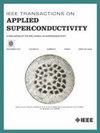Systematic Studies to Enhance Flux Pinning of (BaZrO3/YBa2Cu3O7-x)N Multilayer Thin Films for the Full Landscape of T = 30 K to 77 K
IF 1.7
3区 物理与天体物理
Q3 ENGINEERING, ELECTRICAL & ELECTRONIC
引用次数: 0
Abstract
The (M/YBa2Cu3O7-x)N multilayer thin film structure has been studied by many groups, and achieves different microstructures and artificial pinning centers that result in large variations of critical current density ((BaZrO3/YBa2Cu3O7-x)N多层薄膜在T = 30k ~ 77k全景观下增强通量钉钉的系统研究
(M/YBa2Cu3O7-x)N多层薄膜结构在T = 30-77 K、Happl = 0 - 9 T、0°≤Happl(θ)≤90°的大景观空间内,实现了不同的微结构和人工钉钉中心,导致临界电流密度(Jc)变化较大。本文对脉冲激光沉积制备的(BaZrO3,y/YBa2Cu3O7-x,z)N多层膜进行了广泛的优化研究。研究的工艺参数包括YBa2Cu3O7-x (YBCO)层厚度为3 ~ 300 nm, BaZrO3 (BZO)层厚度为0.5 ~ 1.5 nm,薄膜生长温度为775 ~ 825℃。系统地绘制了临界转变温度(Tc)和临界转变温度(H,T,Θ)随YBCO层厚度和BZO添加量达到16%体积%的函数图。Jc(H,T,θ)在30 ~ 77 K范围内随工艺参数的变化而变化,例如在77 K时,在825℃的工艺温度下,焊剂钉钉的优化效果最佳。然而,在30 K的工作温度下,熔剂钉钉对BZO+YBCO膜参数的敏感性要小得多,在805℃的工艺温度下略有优化。对于所研究的所有H、T条件,在BZO = 8-12体积%添加量时,Jc(H,T)值达到最大值,这与已发表的通量钉钉模型非常吻合,并且所需的BZO层厚度< 0.6 nm。
本文章由计算机程序翻译,如有差异,请以英文原文为准。
求助全文
约1分钟内获得全文
求助全文
来源期刊

IEEE Transactions on Applied Superconductivity
工程技术-工程:电子与电气
CiteScore
3.50
自引率
33.30%
发文量
650
审稿时长
2.3 months
期刊介绍:
IEEE Transactions on Applied Superconductivity (TAS) contains articles on the applications of superconductivity and other relevant technology. Electronic applications include analog and digital circuits employing thin films and active devices such as Josephson junctions. Large scale applications include magnets for power applications such as motors and generators, for magnetic resonance, for accelerators, and cable applications such as power transmission.
 求助内容:
求助内容: 应助结果提醒方式:
应助结果提醒方式:


